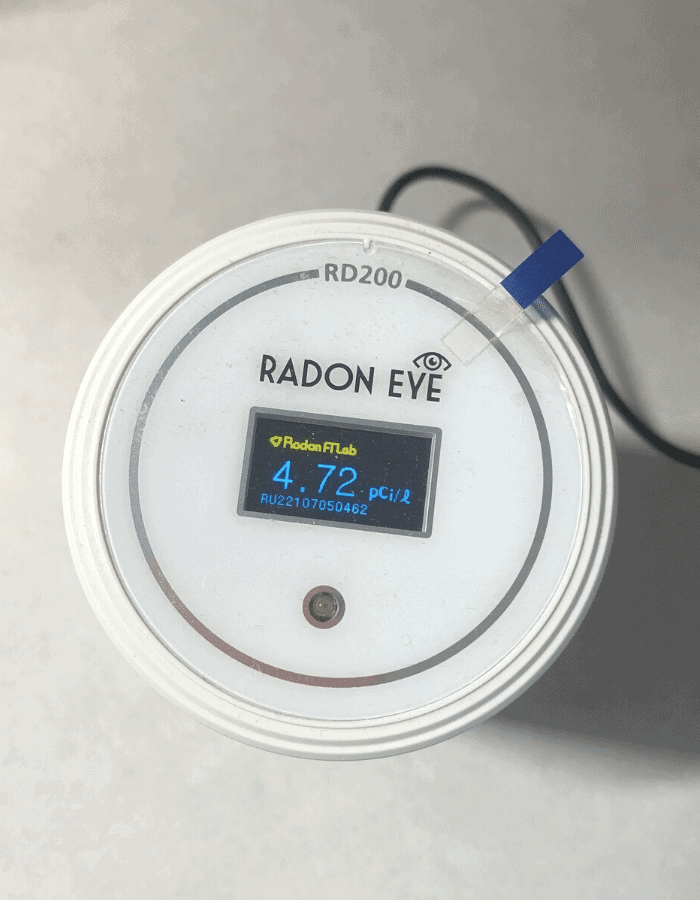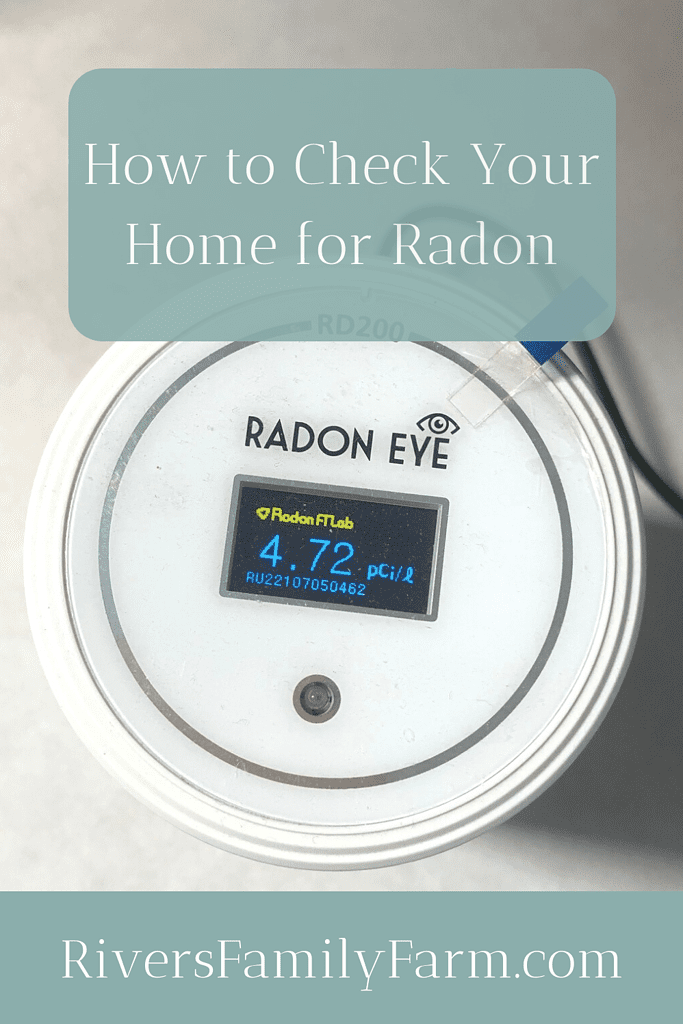How to Check Your Home for Radon
Air quality is one of the most important things you live with and I want to show you how to check your home for radon. Winter is a time when most of us stay indoors and run the heat or keep the fireplace going. Likewise, summer is a time when we stay indoors and run our air conditioning. We rarely think about air quality but we should! Clean air is one of those things most of us take for granted. If we can’t smell any odd odors, we assume that our air is clean. After all, most of us use air filters, right? But what about invisible, odorless, toxic gases that can harm you?

This post contains affiliate links, which means I make a small commission at no cost to you if you place a qualifying purchase through any of the links. Click here for my full disclosure. Thanks for your support!
Homesteading is a long game and we need to strive to stay healthy so we can live out our dream!
According to the United States Environmental Protection Agency (EPA), radon gas is a naturally occurring radioactive gas that can cause lung cancer. Breathing radon over time increases your risk of lung cancer. Radon is the second leading cause of lung cancer in the United States because the EPA estimates that about 21,000 people die each year from radon-related lung cancer. Only smoking causes more lung cancer deaths.
What is Radon?
Radon gas is colorless, odorless, and lacks the ability to move around much. It’s radioactive because it comes from uranium, thorium, and radium (radioactive metals). These metals break down in the earth over time and the radon gas seeps up through the ground into our air, water, and homes.
Radon disperses naturally outdoors and doesn’t pose a health risk. The problem comes when the radon gas seeps into homes and buildings through cracks and gaps and becomes trapped inside.
Where is Radon the Highest?
If you live in the United States, you can check out the EPA’s Radon Zone Map to find your radon exposure risk. The southeast generally has the lowest amount of naturally occurring radon. The highest amount of radon is in the northern half of the country. However, people in all states should regularly check their home for radon. The acceptable level of radon in the US is 2 pCi/L (picocuries per liter of air). The EPA recommends remediation when it reaches 4 pCi/L.
If you live outside of the United States, there’s a helpful article here: Country/region-specific information on radon. Norway had the highest level of radon at or above 10 Bq/m3 (becquerels per cubic meter). One Picocurie [pCi] = 0.037 Becquerel [bq]. Here’s a conversion calculator if you’re interested.
How to Check Your Home for Radon
Get a Home Inspection
You may already be aware of your radon exposure if you’ve ever had a home inspection. When we bought the farm at the end of 2020, we opted to pay the extra fee for the radon test and the home inspector was very surprised. He told us very few homeowners in our area actually check the radon in their homes when they’re paying for a home inspection.
The home inspector set up some meters throughout the house and then shut the doors and windows so the meters could test the air over a 24-hour period. When the results came back, he told us that the radon level was higher than the safe limit and we would need to pay for radon remediation. (Our home was an average of 4.4 pCi/L and the EPA’s safe limit is 4.0 pCi/L.)
We had a company come out to take a look and give us a quote on how we could fix the high radon levels. They told us they would need to drill through the concrete basement, install pipe along the basement floor along with a radon fan to create negative pressure, and then put down a plastic vapor barrier to prevent future radon from seeping up. The radon fan would blow the radon through the pipe and it would exhaust outside. They wanted thousands of dollars to do the job.
Then my sweet husband suggested we buy a home radon meter and open the windows. Genius!
Buy a Radon Meter
Instead of paying thousands of dollars for a radon system, we paid less than two hundred dollars for a home radon meter. We actually bought two…one for the basement and one I like to keep in the kitchen.
I think it may be a myth that radon is higher in basements because our basement levels are generally the same as the upstairs levels.
How to Get Rid of Radon in Your Home for Cheap
On any given day, I’ll check the radon meter and if it’s high I’ll open up some of the windows and run the ceiling fans. How simple is that?! And CHEAP!!
To give you an example of how high our radon gets, below is a picture I took of the meter in the morning. It was at 4.72.

I opened some windows and turned on the ceiling fans. After a couple hours, the radon level went down dramatically and stayed that way for the rest of the day and night. It went down to 1.65! Then I shut the windows and went on about my day.

We’ve noticed that the levels spike after it rains. We assume it’s because the water going down into the earth pushes all the radon gas up. Also, if it’s a particularly dense and overcast day the levels will go up more than normal. Opening windows and running ceiling fans is the remedy.
Important Takeaways
If you don’t have a habit of opening your windows and doors, try to set reminders to get that fresh air indoors. If you can afford a home radon meter, I recommend that you get one just so you know what’s in your home.
In the spring and fall when temperatures are moderate and I’m not running the air conditioner or the heater, I’m not losing any electricity by opening up the doors and windows. Ceiling fans require very little energy to run.
In the summer when it’s very hot, I’ll open my windows at night when temperatures are at their lowest. Ceiling fans in the bedrooms keep us cool at night along with the night air. I generally do this anyway throughout the summer so we don’t have to run our A/C as much. You’d be surprised how quickly the house will cool down with all the windows open!
In the winter when we hit cold temperatures (cold for us), I won’t open our windows until midday when temperatures are at their highest. In Alabama we don’t see very low temperatures and we rarely see snow.
The point is to use your judgment and do the best you can if you have high radon levels.
Remember that radon takes a long time of high exposure to turn into cancer, so occasional spikes with dips won’t hurt you.
I hope this post encourages you to be informed about your air quality! I wish everyone had a radon meter in their home so that the 21,000 people who die each year would still be alive to love on their families!!
Shop This Post
Home Radon Detector (we bought two of these)
Carbon Monoxide Detector, 3 Count (This is equally as important to monitor.)
Other Post You May Enjoy
Pin It For Later!








Oh my goodness this is nothing I had ever considered before! Thank you for brining this to light. It is definitely something I plan to look into now.
Radon is something hardly anyone thinks about! I hope you can spread the word to your loved ones, also! If we can prevent just one radon-related lung cancer it’ll be worth it!
Such great information. I literally had no idea, I’ve heard of radon but really hadn’t looked into it very much. Thank you for bringing it to my attention!
I hope you’ll spread the word to your loved ones, also!
Very interesting! I had no idea. Fresh air makes all the difference.
Yes, the secret is fresh air!! Who knew?! It’s a cheap fix and it works!
This is so helpful thank you!
So important as I prefer to keep our windows closed 365 days a year. My wife is the only one who opens them. We’ll have to take a look into this as lung issues already run deep in our house.